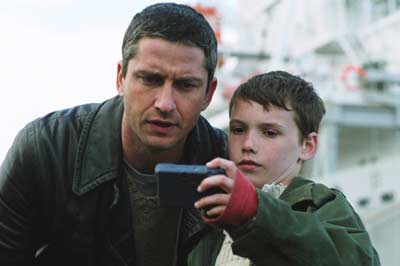1. Discussion Questions for Use With any Film that is a Work of Fiction.
2. In the beginning of the film, Frankie’s voice-over introduces the fact that the family — Frankie, his mother, and grandmother — are moving again. What is implied, other than the simple fact that the family moves often, in the use of the word “again”?
Suggested Response:
This word hints that there is a problem in the family’s situation that results in instability. Possibly the family is fleeing an untenable situation. This is the beginning of the unfolding of the story of the family and how Frankie became deaf. It is part of the setting for the story. [Setting]
3. Frankie’s character is revealed in his interaction with Marie, the waitress at the fish and chips shop. What do we learn about Frankie from this exchange?
Suggested Response:
Frankie is a confident boy who feels free to challenge. His deafness does not hold him back from getting what he wants. [Characterization]
4. What is revealed about Frankie when his mother finds his hearing aid in his pocket and tells him that he must wear it?
Suggested Response:
Frankie does not seem to feel handicapped by his hearing impairment to the point that he needs an aid to make his life easier. This implies that he has accepted his condition with a degree of comfort. Another, equally valid response, is that like many other kids with disabilities, Frankie wants to be just like other kids and doesn’t want to wear the hearing aid. [Characterization]
5. Frankie’s teacher tries to prepare the students in the class to accept a deaf student. How might the teacher have done a better job in her exchange with the kids?
Suggested Response:
Answers will vary. The teacher did not seem to know about Frankie’s ability to read lips and behaved in a way that was unnatural and seemed to bring undue attention to Frankie’s impairment. She failed to introduce him as an individual, focusing instead on his deafness. [Characterization; Theme]
6. What is revealed about Frankie’s character and interests in the opening scenes?
Suggested Response:
Frankie loves geography and the ocean. He appreciates the mural in his apartment building showing boats and fish. He enjoys seeing the fish in the tanks at the pet store. He is interested in books and learning. [Characterization]
7. The bet Ricky makes with Frankie is a turning point in the film. It advances the plot, sending Lizzie in search of someone to impersonate Frankie’s father. In literary analysis, the bet is called a complication, sometimes defined as an event which intensifies the conflict in the story. A complication builds up, accumulates, and develops the central conflict in a work of fiction. Complications often, but not always, occur from the characters’ attempts to find solutions to their problems; they can also simply be events that affect the characters. Complications always result in changes in the lives of the characters and advance the plot. Name another complication in the story.
Suggested Response:
There are at least two other complications in the story. One is the arrival of the Accra at the port in the town to which Frankie and his family have just moved. Another is Davy’s desire to see his son before he dies. [Complication]
8. What is Lizzie feeling when she catches Frankie snooping in her room looking for information on his Dad? She says to him, “I’m the one that’s here, Frankie. I’m the one that’s still here?”
Suggested Response:
Despite the fact that Lizzie is totally devoted to her son, he seems to think that his father is more important than his mother. This often occurs in situations in which one parent is absent from the family. In truth, the parent who is present is more important to the child. However, the child’s thoughts turn to the dead or absent parent because of the child’s unfulfilled need for that parent. This hurts the feelings of the parent who is present, and Lizzie is expressing her hurt. [Theme; Characterization]
9. What idea is Lizzie trying to impress on her son when he asks who he looks like?
Suggested Response:
Lizzie tells her son that he looks like himself. She is trying to press upon him a sense of individuality that transcends the influence of a father or a mother. [Theme]
10. When Lizzie attempts to find a man to pretend to be Frankie’s father she goes into a bar and is accused of being a prostitute. What is the author saying?
Suggested Response:
The author is telling us that Lizzie is now embarked on a perilous course. What if the man that she chooses to play Frankie’s father is as crude as the men in the bar? What if he is a sexual predator? This incident could be seen as a symbol of the risk that Lizzie is undertaking. [Symbol; Theme]
11. After Frankie watches his mother, grandmother, and Marie singing, he seems happier. He then leaves and Marie finds him sitting on a hill overlooking the bay. She confides in Frankie that this is her favorite place in the whole world. What seems to have provoked Frankie to run off?
Suggested Response:
Answers will vary. Students may think that Frankie sees his mother happy for a moment and wants a moment of happiness himself. He wants to find his father. [Theme; Characterization]
12. The relationship Frankie develops with his ersatz father seems to work on several levels. What seems to make the two comfortable with one another?
Suggested Response:
Answers will vary. The two seem to have in common the sea, an interest in fish, and a love for boats and skimming rocks. They both have an underlying loneliness that is mitigated a bit in their relationship. When Marie tells the man that Frankie is a vegetarian when the two come into the fish and chips shop, the man says, “No fish for me” in respect for Frankie’s values. [Characterization]
13. When Frankie and the stranger playing his father go out for a walk, Lizzie follows. What is her worry?
Suggested Response:
Lizzie realizes the risk she has undertaken by entrusting Frankie to a stranger and telling him that he can trust the man because the man is his father. [Theme; Complication]
14. What irony can be found in Lizzie’s challenge to the man she has hired to play Frankie’s father when he wants more time with the boy?
Suggested Response:
When Lizzie says, “Who gave you the right to come in here. . . .?” the stranger says, “You did.” This is irony because it points out to Lizzie that the entire business in which they are engaged is completely her own fabrication. She must assume full responsibility for this. He then tells her she must trust somebody, someday, further adding to the irony because she apparently hired him without trusting that he would do a good job. [Irony, Theme]
15. When Lizzie learns that Frankie’s real father is dying and wants to see Frankie, she refuses. What do you think about this decision?
Suggested Response:
Answers will vary. Years later, after his father has died and Frankie learns the whole truth, he may resent the fact that his mother never let him see his father. However, it is clear that once again Lizzie is trying to protect her son. In the encounter with Davy in the hospital his violence is seen and later Lizzie reveals that Frankie is deaf because of that violence. Lizzie says to Davy’s sister that he had nearly killed both Frankie and her. This news may or may not influence a student’s answer to the question. [Theme]
16. The stranger and Lizzie seem to be developing a relationship of their own, to the delight of Frankie. In a conversation between the two of them, the stranger says that Frankie is a lucky boy. Lizzie says, with regret, that she lies to her son every day. The stranger replies that she protects him every single day. What attitude toward the truth is revealed in this exchange?
Suggested Response:
Answers will vary. Students should note that the man is expressing the idea that some things are more important than the truth, a position held by many people who believe firmly in ethics but who believe that a given situation shifts the value of truth. In this case, protecting Frankie is paramount. Lizzie is feeling the fact that dishonesty, even a ruse to protect a child, has a tendency to separate people from each other. Lizzie always has to filter what she says to Frankie to make sure that it doesn’t contradict the deception; she can never be truly open with him. [Theme]
17. When the stranger is in Frankie’s room, Frankie gives him a sea horse that he has carved and speaks for the first and only time in the film. He says, “You’re coming back” in a tone that is more a statement than a question. The man tells Frankie to remember, “We’re all connected.” What values are illuminated here?
Suggested Response:
Answers will vary. Students should consider the idea that connections between individuals are not forged by blood ties alone, that the power of love is transcendent. [Theme]
18. At the hospital, Lizzie tells Davy, “He’s not your son, he’s mine.” She tells him that he doesn’t deserve Frankie’s forgiveness. This may seem harsh, considering the man is dying. What do you think about Lizzie’s reaction to Davy?
Suggested Response:
A good response will note that being a parent is more than just a biological relationship. It’s being there for your child, day-in and day-out; caring for the child; controlling your anger in the child’s presence, etc. Students may note that even on his death bed, Davy is violent and that Lizzie returns later with a picture of Frankie. This shows that her interest is not in getting back at Davy but in protecting Frankie. [Theme; Complication]
19. In the denouement of the film, Lizzie tells Frankie that his father has died and she learns that the stranger was Marie’s brother, suggesting that their relationship can easily develop further. Frankie skims a rock, reminding the audience of what the stranger had tried to teach him, and writes another letter in which he says his real dad has died. He signs the letter, “Your friend,” rather than “Your son.” What do these elements of denouement serve to communicate?
Suggested Response:
Answers will vary. The end of the film raises several questions. Did Frankie know all along that the stranger was not his father? Was he trying to protect his mother by responding to the letters? At the end of the film, Lizzie and Frankie are sitting in silence at the special place overlooking the harbor. There seems to be no need to discuss how the truth has come out or what the future may bring. Hope is represented in the act of skimming the rock and the fact that they are on the hill together. [Theme; Complication]
20. If Frankie did know that the stranger was not his real father but went along with his mother’s ruse, what does that say about Frankie?
Suggested Response:
There are several good responses: that he is wise beyond his years; that he loves his mother so much that he is willing to go along with her subterfuge so that she can feel that her efforts to promote his happiness are succeeding or, following a different theory, that he so desperately wants a father that he will take anything that his mother can provide, be it a fake letter or a stranger. [Characterization; Theme]
21. A particularly risky thing that Lizzie did was to put her son in the control of a complete stranger. What does this tell us about the risks of deception, even deception that is intended to protect someone else?
Suggested Response:
Lies often lead to more lies and sometimes people are led into dangerous situations to keep the lies from being discovered. Lizzie had not expected the Accra to dock in the town and she had not expected Frankie to make the bet. The only way that she could think to solve the problem was to add another deception to the ruse and find someone to play the part of Frankie’s father. She was lucky that the man turned out to be helpful. [Theme]






